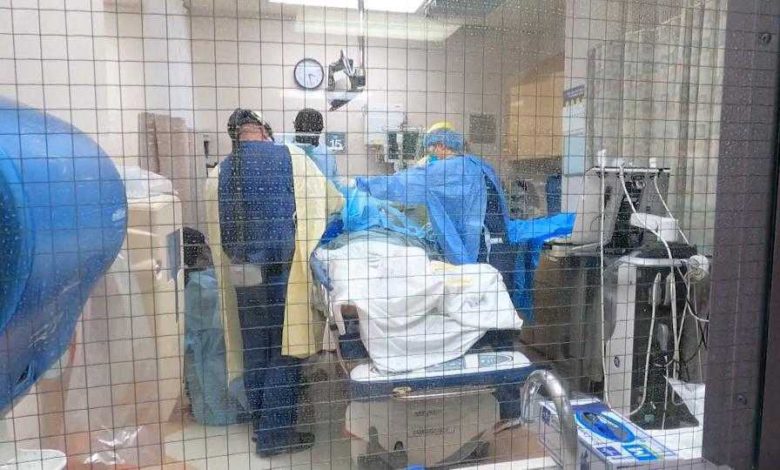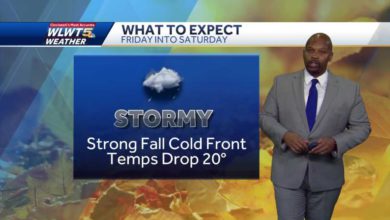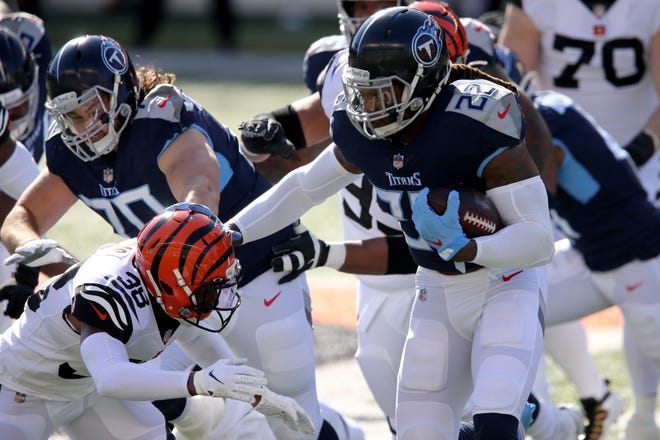

As a record number of Americans are infected with COVID-19, largely due to the rapidly spreading omicron variant, some states' health care systems are beset with nearly full intensive care units.Four states have less than 10% remaining capacity in their ICUs, according to data Wednesday from the U.S. Department of Health and Human Services: Kentucky, Alabama, Indiana and New Hampshire.And as infection spreads, states and health care systems nationwide are handling shortages of available medical workers, who face a greater chance of COVID-19 exposure and must isolate after testing positive.Members of the National Guard and other federal emergency teams have been deployed to hospitals and long-term care facilities in places such as New Hampshire to alleviate the burden with medical and non-medical tasks."This is part of the winter surge, part of the long haul, which is why we put so many of the mitigation strategies and measures in place early on to help provide some flexibility to hospitals and health care systems," New Hampshire Gov. Chris Sununu said Wednesday.Five other states are very close to just 10% of ICU capacity remaining, according to HHS data: New Mexico, Missouri, Rhode Island, Mississippi and Georgia. Nationally, COVID-19 hospitalizations have reached record highs with at least 151,261 Americans need care as of Wednesday.Early research indicates the omicron variant may produce less of a chance of needing hospitalization than prior COVID-19 variants. But omicron's increased transmissibility means more people at higher risk for severe disease, such as those who are unvaccinated or immunocompromised, will be infected."Omicron continues to burn through the commonwealth, growing at levels we have never seen before. Omicron is significantly more contagious than even the delta variant," said Kentucky Gov. Andy Beshear Monday. "If it spreads at the rate we are seeing, it is certainly going to fill up our hospitals."While conditions are not as dire as at the start of the pandemic nearly two years ago due to the availability of vaccines and other treatment options, the staffing shortages in hospitals is a real concern during this latest surge, said Dr. Craig Spencer, director of global health in emergency medicine at New York-Presbyterian/Columbia University Medical Center."The problem is that right now we have hospitals where there's not enough nurses to take care of the patients who are coming in, the COVID patients and the non-COVID patients," Spencer told CNN Wednesday."That's exactly why we need to do everything we can to try to limit the number of people that are infected, not just those that are older or unvaccinated or not boosted, but everyone. Because each infection represents a potential to infect more people. We need to do what we can to slow that spread right now and ease the pressure on our hospitals," Spencer said.For those who come into emergency rooms for non-COVID reasons yet test positive, hospitals are still having to invoke quarantine protocols for those patients which puts a strain on operations, he said. And that can have an effect on all patients."Right now, we're still seeing sick people that need oxygen, the overwhelming majority of which are unvaccinated. But a lot of the patients that we're seeing right now have underlying chronic conditions that are being exacerbated," Spencer said.Those patients, he said, can include "someone who gets COVID is dehydrated and needs to stay in the hospital, or someone who gets COVID and is too weak and they can't go home because they're a fall risk. Those aren't as bad in one sense as those kind of classic COVID patients we were seeing before. But every single patient that needs to stay in the hospital takes up a bed. And beds and staffing are what's in short supply right now."CDC to update mask guidanceHealth experts are reiterating the need to wear quality masks as never-before-seen figures of positive COVID-19 cases strike the country.The U.S. averaged more than 771,580 new COVID-19 cases daily over the past week, according to Johns Hopkins University data, more than three times that of last winter's peak average.The U.S. Centers for Disease Control and Prevention plans to update information about mask-wearing, including the different levels of protection that various masks — such as cloth, surgical or N95 — provide against the spread of COVID-19, CDC Director Dr. Rochelle Walensky said during a White House virtual briefing Wednesday.Overall, it is important for people to wear any face mask that they have access to, "but Omicron has changed things a bit because it is so transmissible that we know that masks are even more important," Lori Tremmel Freeman, chief executive officer of the National Association of County and City Health Officials, told CNN Wednesday."And if you have the chance, if you have the opportunity, if you have access to a better mask, then the recommendation would be to wear it," she said, adding that N95 and KN95 masks need to be fitted properly to provide the best protection possible.Vaccines effective with adolescents, study showsThe rate of deaths in the U.S. has remained lower than during last year's winter surge, which is often credited to around two-thirds of Americans eligible for vaccines being fully inoculated, according to the CDC.The country has averaged 1,817 COVID-19 deaths a day over the past week, JHU data shows. The peak daily average was 3,402 one year ago on Jan. 13, 2021.However, the latest CDC ensemble forecast predicts a potential 62,000 new COVID-19 deaths over the next four weeks, meaning preemptive vaccinations are still needed.The age group of Americans who are the least vaccinated remains those under the age of 18, and a new study of real-world hospital data between July and late October points to the effectiveness of vaccinations even for those who, by being younger, are generally at lesser risk.The findings, published Wednesday in the New England Journal of Medicine, show that the Pfizer/BioNTech coronavirus vaccine appears to be 94% effective against COVID-19 hospitalization among adolescents ages 12-18 in the U.S."Vaccination averted nearly all life-threatening COVID-19 illness in this age group," wrote the researchers from the CDC and a collection of hospitals and universities, who found that far more adolescents hospitalized with COVID-19 were unvaccinated compared with those who were hospitalized for other reasons.Among the hospitalized adolescents with COVID-19, 4% were fully vaccinated, less than 1% were partially vaccinated, and 96% were unvaccinated. In comparison, of those who did not have COVID-19, 36% were fully vaccinated, 7% were partially vaccinated, and 57% were unvaccinated.
As a record number of Americans are infected with COVID-19, largely due to the rapidly spreading omicron variant, some states' health care systems are beset with nearly full intensive care units.
Four states have less than 10% remaining capacity in their ICUs, according to data Wednesday from the U.S. Department of Health and Human Services: Kentucky, Alabama, Indiana and New Hampshire.
And as infection spreads, states and health care systems nationwide are handling shortages of available medical workers, who face a greater chance of COVID-19 exposure and must isolate after testing positive.
Members of the National Guard and other federal emergency teams have been deployed to hospitals and long-term care facilities in places such as New Hampshire to alleviate the burden with medical and non-medical tasks.
"This is part of the winter surge, part of the long haul, which is why we put so many of the mitigation strategies and measures in place early on to help provide some flexibility to hospitals and health care systems," New Hampshire Gov. Chris Sununu said Wednesday.
Five other states are very close to just 10% of ICU capacity remaining, according to HHS data: New Mexico, Missouri, Rhode Island, Mississippi and Georgia. Nationally, COVID-19 hospitalizations have reached record highs with at least 151,261 Americans need care as of Wednesday.
Early research indicates the omicron variant may produce less of a chance of needing hospitalization than prior COVID-19 variants. But omicron's increased transmissibility means more people at higher risk for severe disease, such as those who are unvaccinated or immunocompromised, will be infected.
"Omicron continues to burn through the commonwealth, growing at levels we have never seen before. Omicron is significantly more contagious than even the delta variant," said Kentucky Gov. Andy Beshear Monday. "If it spreads at the rate we are seeing, it is certainly going to fill up our hospitals."
While conditions are not as dire as at the start of the pandemic nearly two years ago due to the availability of vaccines and other treatment options, the staffing shortages in hospitals is a real concern during this latest surge, said Dr. Craig Spencer, director of global health in emergency medicine at New York-Presbyterian/Columbia University Medical Center.
"The problem is that right now we have hospitals where there's not enough nurses to take care of the patients who are coming in, the COVID patients and the non-COVID patients," Spencer told CNN Wednesday.
"That's exactly why we need to do everything we can to try to limit the number of people that are infected, not just those that are older or unvaccinated or not boosted, but everyone. Because each infection represents a potential to infect more people. We need to do what we can to slow that spread right now and ease the pressure on our hospitals," Spencer said.
For those who come into emergency rooms for non-COVID reasons yet test positive, hospitals are still having to invoke quarantine protocols for those patients which puts a strain on operations, he said. And that can have an effect on all patients.
"Right now, we're still seeing sick people that need oxygen, the overwhelming majority of which are unvaccinated. But a lot of the patients that we're seeing right now have underlying chronic conditions that are being exacerbated," Spencer said.
Those patients, he said, can include "someone who gets COVID is dehydrated and needs to stay in the hospital, or someone who gets COVID and is too weak and they can't go home because they're a fall risk. Those aren't as bad in one sense as those kind of classic COVID patients we were seeing before. But every single patient that needs to stay in the hospital takes up a bed. And beds and staffing are what's in short supply right now."
CDC to update mask guidance
Health experts are reiterating the need to wear quality masks as never-before-seen figures of positive COVID-19 cases strike the country.
The U.S. averaged more than 771,580 new COVID-19 cases daily over the past week, according to Johns Hopkins University data, more than three times that of last winter's peak average.
The U.S. Centers for Disease Control and Prevention plans to update information about mask-wearing, including the different levels of protection that various masks — such as cloth, surgical or N95 — provide against the spread of COVID-19, CDC Director Dr. Rochelle Walensky said during a White House virtual briefing Wednesday.
Overall, it is important for people to wear any face mask that they have access to, "but Omicron has changed things a bit because it is so transmissible that we know that masks are even more important," Lori Tremmel Freeman, chief executive officer of the National Association of County and City Health Officials, told CNN Wednesday.
"And if you have the chance, if you have the opportunity, if you have access to a better mask, then the recommendation would be to wear it," she said, adding that N95 and KN95 masks need to be fitted properly to provide the best protection possible.
Vaccines effective with adolescents, study shows
The rate of deaths in the U.S. has remained lower than during last year's winter surge, which is often credited to around two-thirds of Americans eligible for vaccines being fully inoculated, according to the CDC.
The country has averaged 1,817 COVID-19 deaths a day over the past week, JHU data shows. The peak daily average was 3,402 one year ago on Jan. 13, 2021.
However, the latest CDC ensemble forecast predicts a potential 62,000 new COVID-19 deaths over the next four weeks, meaning preemptive vaccinations are still needed.
The age group of Americans who are the least vaccinated remains those under the age of 18, and a new study of real-world hospital data between July and late October points to the effectiveness of vaccinations even for those who, by being younger, are generally at lesser risk.
The findings, published Wednesday in the New England Journal of Medicine, show that the Pfizer/BioNTech coronavirus vaccine appears to be 94% effective against COVID-19 hospitalization among adolescents ages 12-18 in the U.S.
"Vaccination averted nearly all life-threatening COVID-19 illness in this age group," wrote the researchers from the CDC and a collection of hospitals and universities, who found that far more adolescents hospitalized with COVID-19 were unvaccinated compared with those who were hospitalized for other reasons.
Among the hospitalized adolescents with COVID-19, 4% were fully vaccinated, less than 1% were partially vaccinated, and 96% were unvaccinated. In comparison, of those who did not have COVID-19, 36% were fully vaccinated, 7% were partially vaccinated, and 57% were unvaccinated.
Source link









